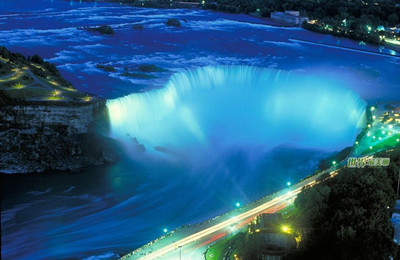在加拿大和美國交界的尼亞加拉河中段地區有一個著名的地理奇觀,尼亞加拉瀑布(Niagara Falls),有著世界七大奇景之一的美譽。關于它的說法有很多,在美國:“馬蹄瀑布”(Horseshoe Falls,就是“加拿大瀑布”,它狀如馬蹄)、“美國瀑布”(American Falls)和“新娘面紗瀑布”(Bridal Veil Falls)。“新娘面紗”在寬闊的“美國瀑布”旁邊,盡管只細細一縷,卻自成一支,所以美國人“宣告”了它的“獨立”。這樣樂樂稱道的瀑布經常會出現在托福考試中,以下是托福考試備考資料:

正文:
Niagara Falls comprises three distinct cataracts. The tallest are the American and Bridal Veil falls on the American side, separated by tiny Luna Island and plunging over jagged rocks in a 180ft drop; the broad Horseshoe Falls which curve their way over to Canada are probably the most impressive. They date back a mere twelve thousand years, when the retreat of melting glaciers allowed water trapped in Lake Erie to gush north to Lake Ontario. Back then the falls were seven miles downriver, but constant erosion has cut them back to their present site. The falls are colorfully lit up at night, and many say they're most beautiful in winter, when the grounds are covered in snow and the waters turn to ice.
The best views on the American side are from the Prospect Point Observation Tower (daily; 50¢), and from the area at its base where the water rushes past; Terrapin Point on Goat Island in the middle of the river has similar views of Horseshoe Falls. The nineteenth-century tightrope-walker Blondin crossed the Niagara repeatedly near here, and even carried passengers across on his back; other suicidal fools over the years have taken the plunge in barrels. One survivor among the many fatalities was the Englishman Bobby Leach, who went over in a steel barrel in July 1911 and had to spend the rest of the year in hospital.










